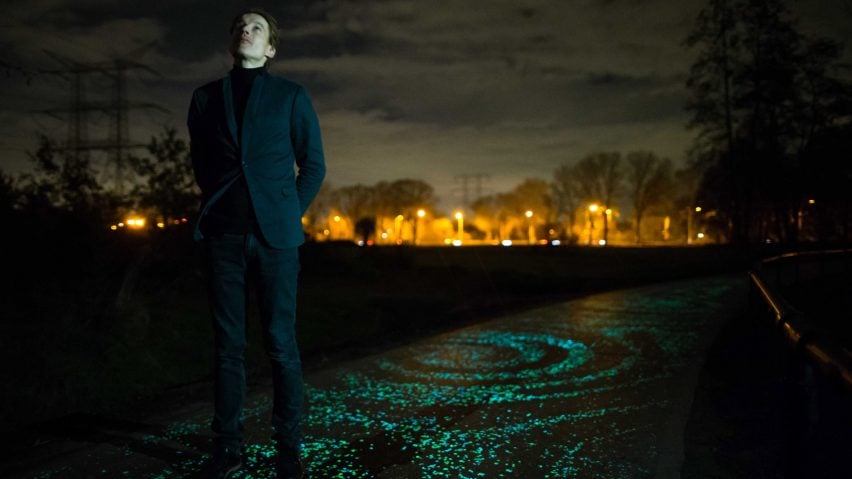Social and technological changes could spark a new era of solar power making it commonplace in the everyday, argues Dutch designer Daan Roosegaarde.
Speaking to Dezeen at one of Soho House's east London locations, a said that if designers can demonstrate the beauty of solar power, people will be more open to integrating it into their lives.
"Solar power will become more embedded like a second skin in our everyday life; giving us energy and allowing us to share it and be more free," Roosegaarde told Dezeen.
"I hope that in the next five to 10 years it won't be only technological advance, but more social and more personal," he said. "Like, where's my solar paint? Or my solar dress? Or my solar suit?"
Whether integrating photovoltaic materials into smaller, personal items could be a viable solution is a topic of debate in the solar industry.
American solar designer Alex Nathanson warned in an interview with Dezeen that solar-powered products are often "a PR stunt".
However, solar-powered personal items are becoming more common, with designer Pauline van Dongen recently releasing a backpack that incorporates tiny solar power beads that can charge the wearer's smart devices and sportswear brand Adidas launching wireless headphones that can be charged by sunshine and artificial light.
Listening to and learning from nature
Roosegaarde believes designers have been unconsciously complicit in creating the problems the world faces and should play an active role in solving them.
"In a way, we have created our emissions: it's bad design, or unconscious design," he said. "So we can be sad, mad and blame somebody else or we can say, 'let's design or engineer our way out of this'."
"We cannot control nature but we can listen to it and learn from it and I think that's the beauty of solar designers – they lead the way," he added.
After over a decade in the industry, 43-year-old Roosegaarde is known for his large-scale light installations that are often centred around sustainability.
Thanks to high-profile works including Smart Highway, a road with photo-luminescent paint to mark out lanes, the Rotterdam-based designer has become known for incorporating solar power into his designs.
"We're not integrating solar power enough in our lives"
One way in which designers are currently making a difference in how people perceive solar power is by slowly transforming it from its previous status as something abstract and "bulky", Roosegaarde suggested.
"Energy harvesting started really rough, like big turbines and big solar cells on rooftops," Roosegaarde said.
"But it is going from brutal, clunky technology on a rooftop to something sensual and part of you," he continued. "It's a technological movement as well as a social one, which is way more interesting, of course."
Despite this, the designer, who founded his design practice Studio Roosegaarde in 2007, said that more needs to be done to convince people to switch to solar energy and invest in a solar-powered future.
"We're not integrating solar power enough in our lives," Roosegaarde said. "We're not using the power of solar beauty to help people to take change," he said. "Let's use beauty as a strategy."
Solar design should demonstrate the beauty of the renewable power
Roosegaarde cites his show Spark, an organic sustainable firework show informed by his love for fireflies at the recent Greenwich and Docklands International Festival, as an example.
Created for the Wellbeing Summit for Social Change in Bilbao-Biscay, Spain, Spark consists of hundreds of biodegradable bubble-like balls that float in the air above visitors.
The photovoltaic film that forms the bubble can absorb natural sunlight as well as artificial light, causing them to glow like fireworks as they float in random configurations in the air.
Spark is designed to be a more sustainable alternative to traditional methods of celebration such as fireworks, balloons, drones and confetti which often create noise pollution and waste.
"Spark is an alternative to the traditional way of celebrating," he said. "It's keeping the tradition but modernising it and showing the beauty that we can still celebrate."
Roosegaarde explained that his interest in using design to solve environmental problems is rooted in his childhood, which he spent in Nieuwkoop during the 1980s in a family of scientists and teachers.
He went on to read fine art at the Berlage Institute in Rotterdam before studying architecture as a post-graduate, and eventually set up his studio in the city.
"If we cannot imagine a better future, we can also not create it"
"I always had a lot of people telling me that what I want is not possible" he recalled. "So maybe the job of the designers to prove them wrong," he said. "If we cannot imagine a better future, we can also not create it."
He attributed his interest in renewable energy to coming from the Netherlands, where around one third of the land is below sea level.
"It's interesting because a huge part of the Netherlands are below sea level," explained Roosegaarde.
"So in a way, we're fighting with nature but also living and learning from nature," he went on. "The whole landscape I grew up in was designed – the windmills, the pumps, the dikes, the dams."
He believes that this is why so many designers at the forefront of the solar revolution herald from the Netherlands.
A crop of designers including Marjan van Aubel and fashion designer Van Dongen who are known for using solar power in their projects come from the country.
"If you zoom out and you apply that thinking to the world of today, it's very normal that we use our landscape as a compass to design with: solar, wind and water management," he reasoned. "Nature tech is in our DNA."
All images are courtesy of Daan Roosegaarde.
Solar Revolution
This article is part of Dezeen's Solar Revolution series, which explores the varied and exciting possible uses of solar energy and how humans can fully harness the incredible power of the sun.

